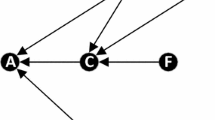Abstract
Using strictly the same parameters (identical two publication years (2004–2005) and identical one-year citation window (2006)), IF 2006 was compared with h-index 2006 for two samples of “Pharmacology and Pharmacy” and “Psychiatry” journals computed from the ISI Web of Science. For the two samples, the IF and the h-index rankings of the journals are very different. The correlation coefficient between the IF and the h-index is high for Psychiatry but lower for Pharmacology. The linearity test performed between the h-index and \( \,IF^{{{\frac{\alpha }{\alpha \, + 1}}}} .\,n\,^{{{\frac{1}{\alpha \, + 1}}}} \) showed the great sensitivity of the model compared with α. The IF and h-index can be completely complementary when evaluating journals of the same scientific discipline.




Similar content being viewed by others
References
Bornmann, L., & Daniel, H. (2007). What do we know about the h index? Journal of the American Society for Information Science and Technology, 58(9), 1381–1385.
Braun, T., Glanzel, W., & Schubert, A. (2006). A Hirsch-type index for journals. Scientometrics, 69(1), 169–173.
Curtis, W., & Hunter, J. (2006). What the impact factor means for surgery journals. World Journal of Surgery, 30, 1368–1370.
Delavalle, R., Schilling, L., Rodriguez, M., Van De Sompel, H., & Bollen, J. (2007). Refining dermatology journal impact factors using pagerank. Journal of the American Academy of Dermatology, 57, 116–119.
Dong, P., Loh, M., & Mondry, A. (2005). The “impact factor” revisited. Biomedical Digital Libraries, 2, 7. doi:10.1186/1742-5581-2-7.
Garfield, E. (1955). Citation indexes to science: a new dimension in documentation through association of ideas. Science, 122, 108–111.
Glanzel, W. (2006). On the h-index—A mathematical approach to a new measure of publication activity and citation impact. Scientometrics, 67(2), 315–321.
Hecht, F., Hecht, B., & Sandberg, A. (1998). The journal impact factor: A misnamed, misleading, misused measure. Cancer Genetics and Cytogenetics, 104, 77–81.
Hirsch, J. (2005). An index to quantify an individual’s scientific research output. Proceedings of the National Academy of Sciences, 102, 16569–16572.
Rousseau, R. (2006). A case study: Evolution of JASIS’ h-index. Science Focus, 1(1), 16–17.
Schubert, A., & Glanzel, W. (2007). A systematic analyse of Hirsch-type indices for journals. Journal of Informetrics, 1, 179–184.
Vanclay, J. (2008). Ranking forestry journals using the h-index. Journal of informetrics, 2, 326–334.
Author information
Authors and Affiliations
Corresponding author
Rights and permissions
About this article
Cite this article
Bador, P., Lafouge, T. Comparative analysis between impact factor and h-index for pharmacology and psychiatry journals. Scientometrics 84, 65–79 (2010). https://doi.org/10.1007/s11192-009-0058-2
Received:
Published:
Issue Date:
DOI: https://doi.org/10.1007/s11192-009-0058-2




